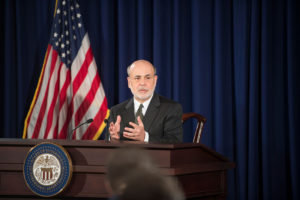
Chairman Ben S. Bernanke during the question-and-answer portion of the press conference on June 19, 2013. The event followed the June 18-19 meeting of the Federal Open Market Committee.
Ten years after Ben Bernanke’s famous 60 Minutes interview, the Fed is looking less likely than ever to unwind the unconventional monetary policies it used to fight the Financial Crisis. Danielle DiMartino-Booth writes for Bloomberg:
If the primary goal was recovery without inflation, the Fed delivered. Since the onset of recovery in June 2009, the core personal consumption expenditures index, which measures the prices paid by consumers for goods and services net of food and energy prices that tend to be more volatile, has been above 2 percent in in just five months in 2018, four in 2012 and one in 2011.
Critics of the central bank suggest that the massive surge in financial assets over the past decade starkly illustrates the need for the Fed to incorporate inflation gauges that take into account price gains of real estate and securities. One such gauge, the Underlying Inflation Gauge (UIG) created at the Federal Reserve Bank of New York, has hovered around the 3 percent level since last February. In other words, the UIG has been running north of the Fed’s 2 percent inflation target since November 2016. The justification for raising interest rates thus depends on the gauge used to guide policy.
As for Bernanke’s commitment to unwind unconventional monetary policy, it’s looking increasingly as if only a small portion of his promise can be fulfilled. Since last meeting in January, Fed officials have been publicly unified in their intention to present a road map to end quantitative tightening (QT) at next week’s Federal Open Market Committee meeting. The 16 percent to 17 percent of GDP estimate Powell offered Congress as the terminal size of the balance sheet implies QT will end with the Fed holding about $3.5 trillion in securities, compared with the peak of about $4.52 trillion in January 2015. (The Fed held less than $1 trillion of balance sheet assets before the financial crisis.)
Read more here.
